Synergistic Galileo PowerCell SX + SRX Power Cable (Super high end)
Original price was: R440,000.00.R180,000.00Current price is: R180,000.00.





The technology for our new SRX power cord comes direct from our SR25 25th Anniversary power cord that was limited to 100 pieces worldwide. The SRX is an exact duplicate of the now sold-out SR25 with one exception, we are using a different grade of pure six-nines silver, and this cuts the cost of our reference power cord in half. Each SRX power cord is fabricated by hand in our California factory including a flexible pure silver signal path ribbon laminate that acts as an Electromagnetic Cell running the full length of the cable from the wall plug to the IEC. Additional AC conductors are made from pure six-nines silver in an Air Dielectric for a total of nine gauge of pure silver each for the hot and neutral run. In every respect, the SRX represents the zenith of what we currently know on building the world’s state-of-the-art power cord. SR technologies include the most advanced UEF shielding we have ever developed for a power cord and the most complex duel folded electromagnetic cells we have placed in a power cord made from pure six nines silver for both the hot and neutral AC leg. With a long flexible flat EM Cell and two folded EM Cells all made from pure six-nines silver, you have in effect a pure silver PowerCell line conditioner in an AC cable format.
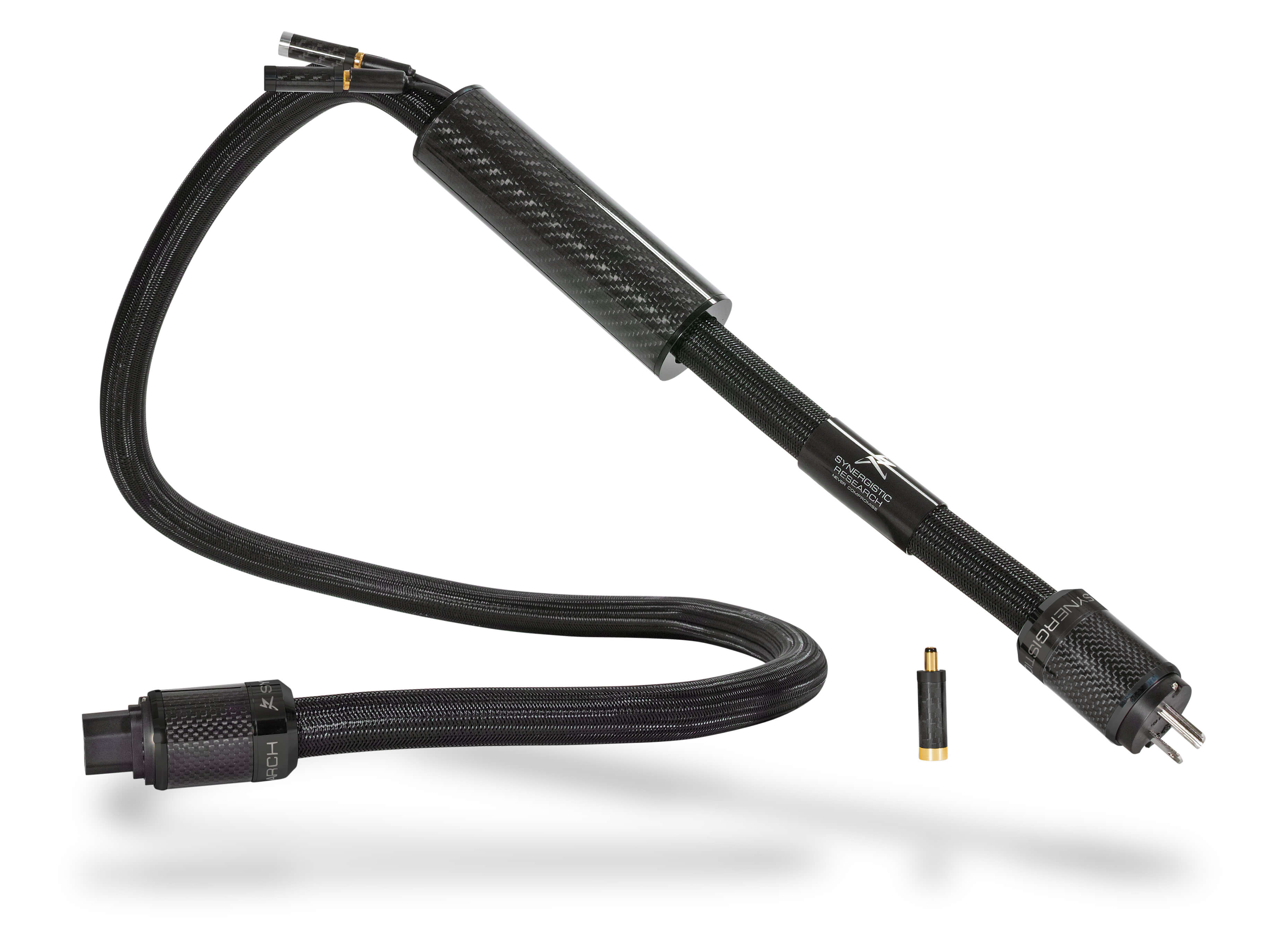
What’s inside?
Additional SR25 technologies include a pure silver Ground Plane that can be connected to our Active Ground Block for a lower noise floor and added holographic sound staging and dynamic impact and a Swiss Made power supply developed to optimize the pure silver EM Cells. SRX has the exact same wall and IEC connectors developed for the SR25 made from Carbon Fiber and special Rhodium contacts selected in blind listening tests for their perfect sonic balance within the sound of the cable itself. Each SRX power cord comes with two carbon fiber UEF Tuning Modules specially voiced for the SRX so you can strike the perfect balance between detail and musicality for your system. To voice SRX to your system listen to the Gold (warm) and the Silver (detail) bullet and select the option that makes music in your system. Needless to say, this is the most holographic, lowest noise floor and dynamic and musical power cord in our line-up. This power cord is exceptionally well suited for use with our PowerCell 12SE line conditioner as just one SRX can improve the performance of your PowerCell and this improves every connected component in your system.
Synergistic Research SR25 Limited Edition Power Cord
- Written by: Howard Kneller
 An audio system’s sound quality can be affected by, among other things, the type of signal cables, vibration-management products, and room treatments used. However, there is perhaps no more important variable than power. Whether this is due to the essential role that power plays in a signal’s generation, as opposed to its conversion or distribution, is hard to say. What is certain is that the stream of ever-better-performing power products installed in my system over the years has never failed to impress me.
An audio system’s sound quality can be affected by, among other things, the type of signal cables, vibration-management products, and room treatments used. However, there is perhaps no more important variable than power. Whether this is due to the essential role that power plays in a signal’s generation, as opposed to its conversion or distribution, is hard to say. What is certain is that the stream of ever-better-performing power products installed in my system over the years has never failed to impress me.
In 1992, founder Ted Denney opened the doors of Synergistic Research. One of the first audiophile companies to recognize the importance of power to sound quality, SR introduced its first power cord, the AC Master Coupler ($250), in 1994. In late 2017, to celebrate its 25th anniversary, Synergistic introduced its SR25 Limited Edition power cord — a no-holds-barred, cost-no-object cord intended to assail the state of the art of power delivery and that costs $20,000 USD per 5’ cord ($2000 per additional foot). Yes, that’s the cost of one SR25 cord. With no disrespect to Forrest Gump, the Whitewater scandal, or the Netscape browser, this is not 1994.

Denney says that the SR25 represents a tour de force of the technologies he’s developed during his 25 years in audio design. Geometrically complex, extraordinarily difficult and labor-intensive to make, and heavily laden with pure silver, graphene, and carbon fiber, Denney explains that the actively shielded SR25 operates from end to end as a long, flat, flexible, layered electromagnetic (EM) AC-filtering cell. Further, Denney states that it contains two smaller “folded” active EM cells, one each for the hot and neutral legs, to provide targeted filtering.
The bottom line, Denney says, is that the SR25 radically improves an audio system’s performance even when a traditional power conditioner is used. According to him, AC power must be continually filtered as it passes through such a system, or its quality degrades.
Only 100 examples of the SR25 will be made, each by hand in Synergistic’s factory in Santa Ana, California. According to Denney, over half the run has already been sold, many to customers in the Far East.
This would be a good place to stop reading if you (1) believe that power cords can’t change a stereo system’s performance, or (2) are offended by extraordinarily expensive audio products. Those who remain and wish to know what a $20,000 power cord might bring to the world of audio, read on.
Let them drink Goût de Diamants
The SR25 Limited Edition comes in the most striking box I have ever seen containing an audio component, let alone a power cord. Made of carbon fiber with polished metal fittings and lined with black velvet, it’s embossed on the outside with a silver plate engraved with, among other things, Ted Denney’s signature and Synergistic Research’s motto: “Never Compromise.”
Attached to the box’s interior are a large paper certificate with an embossed gold seal and another engraved metal plate, this one black. Here is Denney’s signature again, as well as the cord’s production number (my review sample was No.53). Another such plate is attached to the SR25’s body.

The SR25’s box alone looks as if it costs several hundred dollars — a fact not disputed by Denney. This type of presentation is obviously aimed at folks who appreciate a $250,000 bottle of Goût de Diamants champagne, each of which is adorned with a Superman-style, diamond-shaped pewter label set with a Swarovski crystal, and a second pewter label on the back describing the champagne’s character profile.
Let them eat silver
You’d be hard-pressed to find a power cord whose geometry is as complex and technologically dense as the SR25’s. Strap in and stick with me — there’s a lot to unpack.
The SR25 contains 16 conductors, each of which is used to manufacture a rudimentary speaker cable that is auditioned twice in order to determine its optimal signal directionality. As detailed below, eight of these conductors, some round and others flat, each of pure silver, deliver the AC. The other eight conductors, each a flat mesh of pure copper, provide DC bias and ground for the cord’s active shielding circuitry and the Long EM Cell — a flat, flexible, layered, active EM filtering cell at the SR25’s core that runs its entire length.
The SR25’s shields are activated via a 30V DC bias whose power supply resides within the cord’s body. Unlike with Synergistic’s older active power cords, an external wall-wart power supply, connected to the cord by a cumbersome wire, is not used. Denney states that this type of shielding prevents the noise that is generated when AC current interacts with a dielectric.
According to Denney, the Long EM Cell is a product of the SR25’s unique, active conductor geometry, and is created by tightly sandwiching together four conductors in parallel:
- Two AC conductors carrying flat Air Ribbons of 99.9995% pure silver laminate 0.003” thick and 0.5” wide, 36 square inches per 6’ length, one each for hot and neutral. The Air designation indicates that the conductors are housed in an air-sealed dielectric of polytetrafluoroethylene (PTFE), aka Teflon.
- Two flat Air Ribbons of pure copper mesh, of the same dimensions as the silver Air Ribbons, to provide DC bias and ground for the Long EM Cell.
Denney states that this Long EM Cell very effectively filters AC, thus reducing noise and improving many other aspects of performance. For the Cell’s design, Synergistic has obtained U.S. patent No. 7781917.
Running along the Long EM Cell’s exterior are the SR25’s remaining 12 conductors, some of which carry AC, and others of which carry the DC bias for the cord’s active shield. These conductors are:
- Two AC Air Strings, comprising thin, round, solid monofilaments of 99.99995% pure mono-crystal silver, one each for hot and neutral, one placed atop the other.
- Four high-current AC, comprising round, solid, 14-gauge Air Strings of 99.995% pure silver, at the Cell’s corners.
- Six DC, comprising third-generation cables of pure copper mesh, each encasing and shielding one of the six round silver conductors.
I’ve never seen a power cord contain so much highly conductive silver. One might jest that the SR25’s silver conductors, which collectively add up to a nine-gauge (5/32”) thickness for each of the cord’s hot and neutral legs, can be melted down to forge a small set of tableware. Also remarkable are Synergistic’s specifications of the element, which is produced in the US. Silver that’s 99.99995% pure is extremely pure indeed, and rare and expensive. Denney said that they tried less expensive silver from the Far East, but it sounded comparatively bright and thin.
The SR25’s conductors and other conductive parts are subjected to Synergistic’s Quantum Tunneling, developed in 2007. In this process, conductive materials are treated with 1,000,000V of electricity at certain frequencies and pulse modulations. According to Denney, this allows the active shielding to work more efficiently by improving electron flow.
Also found throughout the SR25 is graphene and Synergistic’s recently developed Uniform Energy Field (UEF) quantum conditioning material. Graphene is a near-superconductor at room temperature, and superconductivity makes possible the transmission of electrical current without resistance or magnetic flux fields. Denney is tight-lipped about the UEF material other than to state that when used with other Synergistic UEF products it acts as a force multiplier, strengthening the sonic effects of those products. I’ve found that Synergistic’s UEF products result in a sound that’s warmer, more detailed, more full-bodied than with the company’s earlier offerings.

Near the SR25’s male connector — the one that you plug into the wall — the cable passes through a thick cylinder of carbon fiber almost 7” long. This contains two actively biased carbon-fiber Folded EM Cells, to provide targeted filtering of the AC’s hot and neutral legs, one cell per leg. Also inside the cylinder is a ground plane and a DC power supply (see below), the latter providing bias to the SR25’s active shielding circuitry and Folded EM Cells.
The Folded EM Cells consist of layers of “folded” silver foil and graphene, and two layers of UEF, all encased in a Teflon dielectric. Characterizing these cells as “folded” suggests that they’re flat. However, each Cell is actually rolled like a capacitor. Denney states that a Cell’s shape affects its inductance properties, and thus performance. Folded Cells, he states, favor bass impact and image focus, while flat Cells (e.g., the Long EM Cell) favor a large, holographic soundstage.
The DC power supply, Swiss-made and modified by Synergistic, is attached to a printed circuit board treated with UEF and graphene. The board contains Synergistic’s proprietary SR Quantum capacitors, and pure silver point-to-point wiring connected with solder that itself is 4% silver.
The SR25 also has two types of EM Cell-based ground planes, the first of which replaces a typical ground wire. This plane runs the Long EM Cell’s length and connects to the ground poles of the AC outlet and the component being powered via the cord’s IEC connectors. Its layers are hot, neutral, UEF, and ground.
The second type of ground plane, two of which are used in the SR25, consists of another Folded EM Cell. These planes are inside the carbon-fiber cylinder, one each near the two other Folded EM Cells, and connect to a small, male mini-banana connector that protrudes from the end of the cylinder nearer the cord’s female IEC connector. The mini-banana is to be attached to an AC outlet’s ground pole with an included ground cable. For higher performance, Denney says that these planes can be connected to one of Synergistic’s optional passive Ground Blocks ($595) or Active Ground Blocks ($1995).
Also protruding from that end of the cylinder are two barrel connectors, each attached to one of two small, removable modules the size and shape of bullets. Denney states that these modules, which serve different purposes, are “voiced” for the SR25.
One module, all black, completes the SR25’s active shielding circuitry, its LED glowing blue when that circuitry is powered. In the event that the module burns out — a very rare occurrence, based on my experience with Synergistic cords — it can be returned to the company for replacement without having to send back the entire cord.
The other module, passive and clad in carbon fiber, attaches through its barrel connector to the SR25’s conductor shields. According to Denney, by changing the cord’s resonant frequencies at a quantum level, this module alters the SR25’s sound, thus permitting it to be tuned. Two of these modules are included; Denny says that the one with a thin gold band provides more warmth, liquidity, and musicality; the one with the silver band increases speed, detail, and refinement.
Finally, the SR25’s carbon-fiber-clad terminations are Synergistic’s own G08 connectors, which feature pins of rhodium-plated brass. According to Denney, unlike Synergistic’s other power cords, which have pins plated with gold or silver, the rhodium-plated brass pins sounded better in double-blind tests than did pins plated with four other metals.

The SR25 has a total of 36 point-to-point connections, and it takes three highly skilled workers several days to build a single SR25 by hand. That done, it undergoes a three-step, five-day burning-in process.
Ted Denney says that, with the exception of Synergistic’s Galileo System (speaker cables, $40,000/pair; two sets of interconnects, $50,000; both discontinued), the SR25 is the most complex, labor-intensive, expensive product Synergistic has ever made. Indeed — rather than a single power cord, I feel I’ve just described a multi-box digital front end.
Setup
The SR25 can be ordered in either a 15A IEC C13 or a 20A C19 configuration. At Denny’s suggestion, the 15A review sample was fitted on its female end with a Neutrik 32A PowerCon connector so that it could send the wall current to my Synergistic PowerCell 12SE power conditioner. Previously, I’d been using the PowerCell with its included Synergistic Atmosphere cord, also fitted with a PowerCon. I typically like to connect a power cord I’m reviewing to only my digital front end, and then to other components. But Denny noted that because the PowerCell feeds every active device in my system, replacing its power cord with the SR25 would be the best idea.
I first listened to the SR25 with its gold tuning module attached, as that’s how the cord was shipped. After plugging in the SR25, I connected the included ground wire to the cord’s mini-banana adapter and to my AC wall outlet. I later switched out that wire for Synergistic’s High Definition Ground Cable, which I attached to a Synergistic Active Ground Block ($1995).
The $20,000 question
Using the SR25 with its gold tuning module brought mixed results. I’ve always believed that the size of the soundstages thrown by my system were limited by my medium-size room, but the SR25 disproved that — those soundstages greatly increased in size. It wasn’t that they were merely bigger than I’d obtained with Synergistic’s Atmosphere power cord — they were bigger than I thought were possible in my room.
The SR25 also dramatically improved image weight. The circle-of-fifths timpani strokes in “Planet Earth II Suite,” from the album of Hans Zimmer, Jacob Shea, and Jasha Klebe’s music for the BBC series Planet Earth II (16-bit/44.1kHz FLAC, Silva Screen Music/Tidal), were now so deeply thunderous that they sounded like a herd of elephants stampeding through my room.
But along with these extraordinary improvements came a loss of imaging, leading edges, detail, and speed. And everything sounded too warm and burnished. For example, Bettye LaVette’s gritty voice in the Who’s “Love Reign O’er Me,” the single live track on her album Interpretations: The British Rock Songbook (16/44.1 FLAC, Anti-/Tidal), was blanketed by a thick layer of unnatural warmth. As a result, it lacked the crisp exterior lines that make the recording so arresting.
Given my prior experiences with Synergistic’s tuning modules, the latter impressions weren’t shocking. Further, I was confident that swapping out the gold tuning module for the silver one would help. But with the gold module, my system’s sound was alarmingly far from where I thought it should be.
“Oh, my.” — George Takei
Lest their heads explode, I hope that all those who believe that power cords can’t change a system’s performance long ago stopped reading. After I’d swapped out the SR25’s gold tuning module for the silver tuning module, it was as if I had a different stereo system.
Back with a vengeance was everything that had disappeared with the gold module, and more. The SR25 now possessed a sonic signature, in my experience unique to Synergistic’s UEF products, that was fast, open, detailed, and resonant, with images that had clean edges yet were round and three-dimensional. This cord sounded lively and exciting. Tonality, too, was now spot on, apparently unaffected by the SR25’s rhodium-plated brass connector pins, which can create a cool tonal balance by attenuating frequencies below about 250Hz. Bettye LaVette’s voice in “Love Reign O’er Me,” for example, was now far more flowing, tonally accurate, nuanced, and finely drawn than it had ever been.

When I advised Denney of my experience with the tuning modules, he was unsurprised. He agreed that the gold module is the wrong choice for the PowerCell in my system, and suggested that it might work great on another component or in another system.
Now properly tuned, the SR25 improved virtually every aspect of my system’s sound — which is always what happens when it’s fed a dose of five-star power. What was unique was the degree of improvement: much greater than I’d obtained not only with any other power cord, including Synergistic’s own Galileo UEF ($5600), but with even most power conditioners. For once in an audio review, the word transformative would not be an overstatement.
The SR25 strikingly enhanced soundstage depth and layering. “Perfect Sense Part I,” from Roger Waters’s Amused to Death (16/44.1 FLAC, Columbia), begins with rabid screaming. Previously, this outburst was restricted to the near vicinity of my speakers. With the SR25, the body, weight, and authority of the voice fundamentally improved, and the outburst startled me as it seemed to emanate from a point only a few feet from my chair.
“Song of the Stars,” from Dead Can Dance’s Spiritchaser (16/44.1 FLAC, 4AD), begins with a low synthesized vibration, an Indian poem, and the sounds of a seashell shaker, and ends with a voodoo incantation. Between these are pentatonic-scale African and Caribbean guitar motifs, percussive strokes, whirling noises, even the call of a kookaburra. With the SR25 feeding the PowerCell, my system created an astonishing sense of envelopment with this song. The shakers were much more solidly placed at the front of the soundstage, and the mix of exotic sounds soared around the room’s sides and rear with much more air and three-dimensionality than ever before.
It was the SR25’s ability to reform the events occurring within the soundfield that led me to rethink numerous classical works, particularly complex ones. Take, for example, the heavily fugal section of the third movement of Brahms’s Piano Concerto No.1, in the recording by pianist Maurizio Pollini, with the Berlin Philharmonic conducted by Claudio Abbado (CD, Deutsche Grammophon 447 041-2). Later in the movement, counterpoint is employed on a smaller scale as Pollini’s hands repeatedly exchange trills and melody. With the SR25, the movement’s complex, rhythmically diverse lines were much more sinewy and easy to follow, and so more fully revealed their relationships. Also more evident was the delicate and utterly gorgeous way in which the trill ornamented the melody. The end result was a lesson, in my experience much more compelling than any before it, that Brahms was the most accomplished contrapuntist of the late Romantic period.

Moreover, the SR25 rendered details that other power cords, regardless of cost or pedigree, gloss over or fail to reproduce. These included, 27 seconds into Bettye LaVette’s performance of “Love Reign O’er Me,” an audience member’s cough. That cough had never so clearly originated from the first few rows of the Kennedy Center in Washington, DC, near the left wall. Through the SR25, the cough’s reverberation off that wall was extraordinary in its verisimilitude.
Audience sounds aside, the SR25 revealed musically significant details, many of them astonishing. With violinist Annar Follesø’s performance of the Fuga of Bartók’s Sonata for Solo Violin, from 2L Sampler 2007: The Nordic Sound (SACD, 2L), the SR25 unraveled the violin’s timbral complexities better than I’d heard before. While the instrument’s soundbox resonates at a single fundamental, its internal parts don’t. As a result, those parts display unique overtones. This causes the violin to sing with a polyphony of voices that is more like that of a choir than a solo vocalist. Many power cords, however, can make the violin’s timbre sound harsh and simplistic.
In the call-and-response of this fugue, the SR25 allowed my system not only to parse the diverse, often overlapping mosaic of pleasing, round, warm, metallic, thin, and shrill sounds, but also to more fully reveal the instances in which a single note had multiple timbres. One visitor to my home who heard this sonata remarked that it was like hearing the violin for the first time.
My system had never before reproduced so many orchestral colors, and instruments had never sounded more like themselves, as they did with the SR25. The B and E strings of double basses had never sounded so somber and earthy. The G4-F5 middle register of the trumpet had never sounded so metallic and brilliant. If the SR25 portrayed the timbre of Follesø’s violin with a precise aural scalpel, Synergistic’s Atmosphere, by all accounts an extremely able power cord, depicted it with a sledgehammer.
I expect that an able power cord will improve the sound of instruments that can operate at extreme frequencies, the production of which requires substantial system resources. In the Bartók sonata, the violin’s metallic, harsh, thin high-frequency notes were reproduced as precisely that. However, those notes also had much more air, and less digital grunge, than when I used the PowerCell’s Atmosphere cord.
At the other end of the audioband are the bottommost notes in the electronic “Hey Now,” from London Grammar’s If You Wait (CD, Columbia 88843 03991 2), reputed to reach a subterranean C1 (32.7Hz). Regardless of the audio gear I’ve played this track through, these notes have always been blurred and bloomy. Through the SR25 they finally snapped into place — each was now free of bloat, and with a precise individual pitch. They also seemed to dip much lower than before. In fact, I repeatedly experienced the SR25’s apparent ability to reveal, in recordings I know well, frequencies lower than any I’d heard in them before.

The SR25’s abilities were also evident with respect to music whose frequencies reside outside of the extremes. This made everyday listening to music much more pleasurable. For example, the SR25 revealed more air, beauty, and refinement in the upper midband (2.5-5kHz). In the Bartók sonata, that region and the region immediately above it sparkled. Switching back to the Atmosphere cord, instruments within these frequencies sounded comparatively flat, and the more they approached and exceeded 5kHz, the glassier they sounded.
The SR25 also worked its magic on attack transients, greatly improving the reproduction of the initial pulse energy created by the collision of two hard objects. In Al Di Meola’s Opus (16/44.1 FLAC, EAR Music), the guitarist plays so many struck-stringed and percussion instruments that Opus can almost be called a solo album. In “Milogna Noctiva,” Di Meola’s Conde Hermanos acoustic guitar plucks, and cajon, snare, and tom strokes, never had so much focus or transient snap or were surrounded by so much space. While improving air and transient attack is what a good power cord is supposed to do, the magnitude of these changes dropped the jaw of even this old power junkie.
Finally, I swapped out the included ground cable for Synergistic’s High Definition Ground Cable, which I attached to the company’s Active Ground Block ($1995). The sound improved substantially. Noise and digital grunge decreased, and clarity, leading edges, decays, soundstaging, and perceived low-end extension further improved. The Active Ground Block costs only about 15% of the SR25’s price, but it improved the sound to a very substantial degree.
Truth to power
Synergistic Research’s complex and difficult-to-manufacture SR25 Limited Edition power cord so stunningly demonstrates the relationship between high-quality power and high-quality sound that it may represent the apotheosis of power-cord design. When I said that the SR25 transformed virtually every aspect of my system’s sound, I wasn’t exaggerating. It was difficult to believe that these improvements were caused by a single power cord, or that my system already contained a high-end power conditioner and cords. Once again, Ted Denney has proven that the simplest circuit is not necessarily the best sounding. Twenty large — enough to buy a new Honda Civic — is a very great deal to pay for a power cord, and most can’t pay it at all. The audiophile masses will take solace in the technologies that I hope will eventually trickle down from the SR25.
Can a $20,000 power cord constitute a bargain? It can, if it delivers a greater improvement in sound than you’d get from spending an extra $20,000 on, say, a six-figure power amp. However, expanding on Ted Denny’s point that a power conditioner can feed every active device in an audio system, I recommend starting with Synergistic’s PowerCell 12 UEF SE conditioner ($6495/120V), which provides the most bang for the buck. But if you choose to forgo the kids’ college educations for the silver-laden SR25, be prepared to experience what could very well be the state of the art of power delivery.
Nota bene, Goût de Diamants drinkers: The extraordinary amount of time and high-quality silver involved in the SR25’s manufacture make it unlikely that Ted Denney will soon be able to match its accomplishments with a lower-cost cord. As Forrest Gump said, that’s all I have to say about that.
Beyond 11.
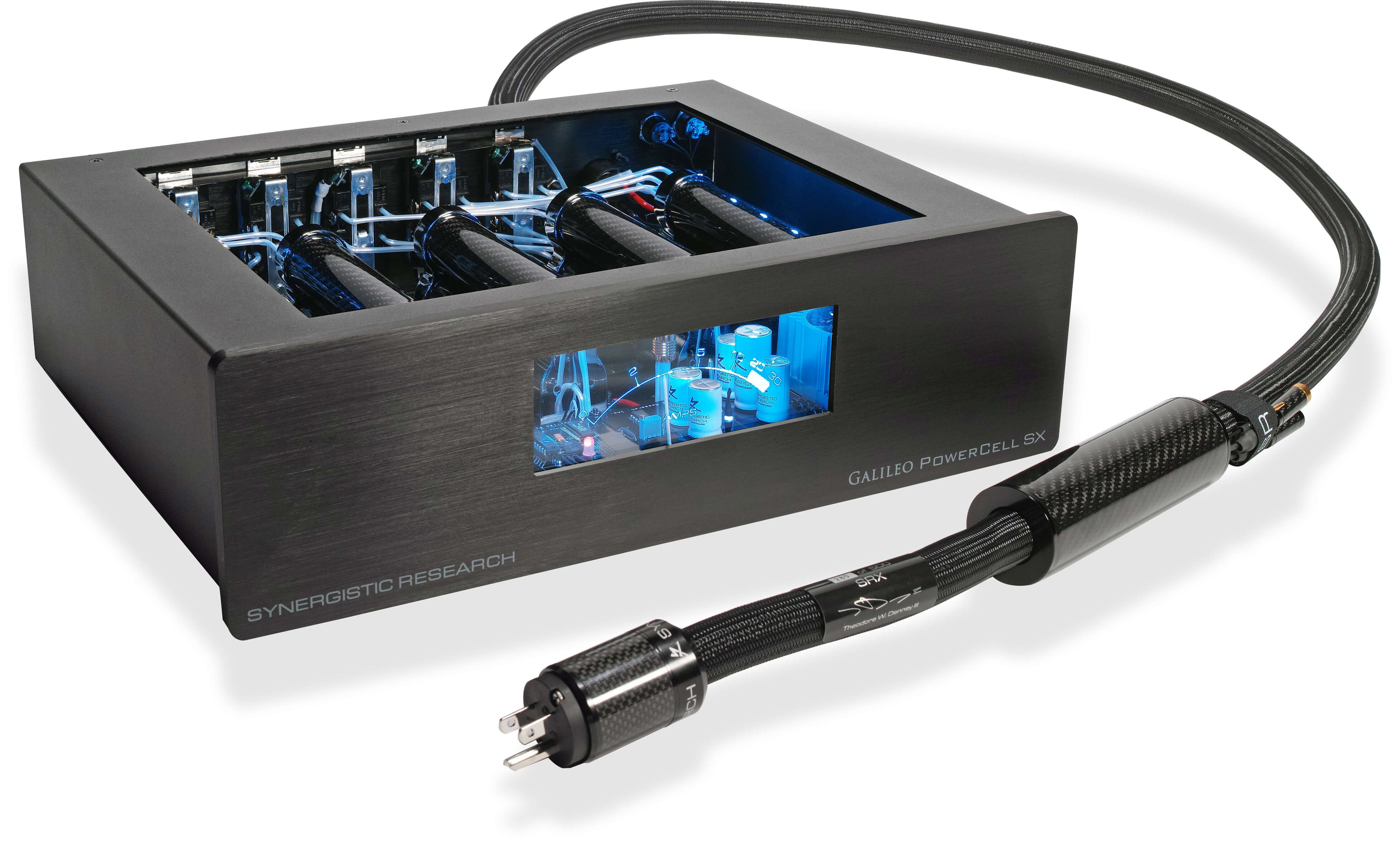
The 2021 Galileo PowerCell SX starts with a complete redesign of its PCB power supply and ULF Signal Generator while keeping all non-conflicting PCB advancements from last year’s model. The first step was to create a multi-frequency ULF generator that splits the balance between intimate, focused recordings and large-scale recordings for a perfect yin and yang of the two. The Red setting is voiced for smaller-scale performances and is especially suited to recordings of analog instruments. Setting Purple is voiced to portray large-scale recordings accurately. It is ideally suited to recordings with massive sound fields like Pink Floyd or any modern recording mastered to portray extreme stereo imaging. To make this possible, we borrowed technology from our Atmosphere Acoustic Field Generator that generates the Earth’s Shuman Resonance plus harmonics of the Earth’s Shuman Resonance simultaneously over two channels to model different acoustic environments. As a result, the Galileo PowerCell SX is the first PowerCell to utilize more than one ULF frequency when biasing its internal EM Cells. We then added technology from our Tranquility Pod to create a uniform EM field beneath the PCB and power supply for a lower noise floor with improved dynamics and soundstaging. We then improved fundamentals like 33% larger and more densely packed folded EM Cells for a significant increase in AC filtration that lowers a system’s perceived noise floor with improvements in dynamics. We then designed a new Purple Duplex with all Purple Fuse technologies for sonic improvements precisely like our state-of-the-art Purple Fuses. Finally, we revoiced the internal Gold UEF tuning circuits to tie the sum of all advances together with a focus on natural sound first, along with improvements in soundstaging. Together these changes result from innovation perfected through 100’s of hours of measurements and listening tests and is the single most significant leap in Galileo PowerCell performance since the introduction of the first 11 x EM Cell Galileo PowerCell of 2019.
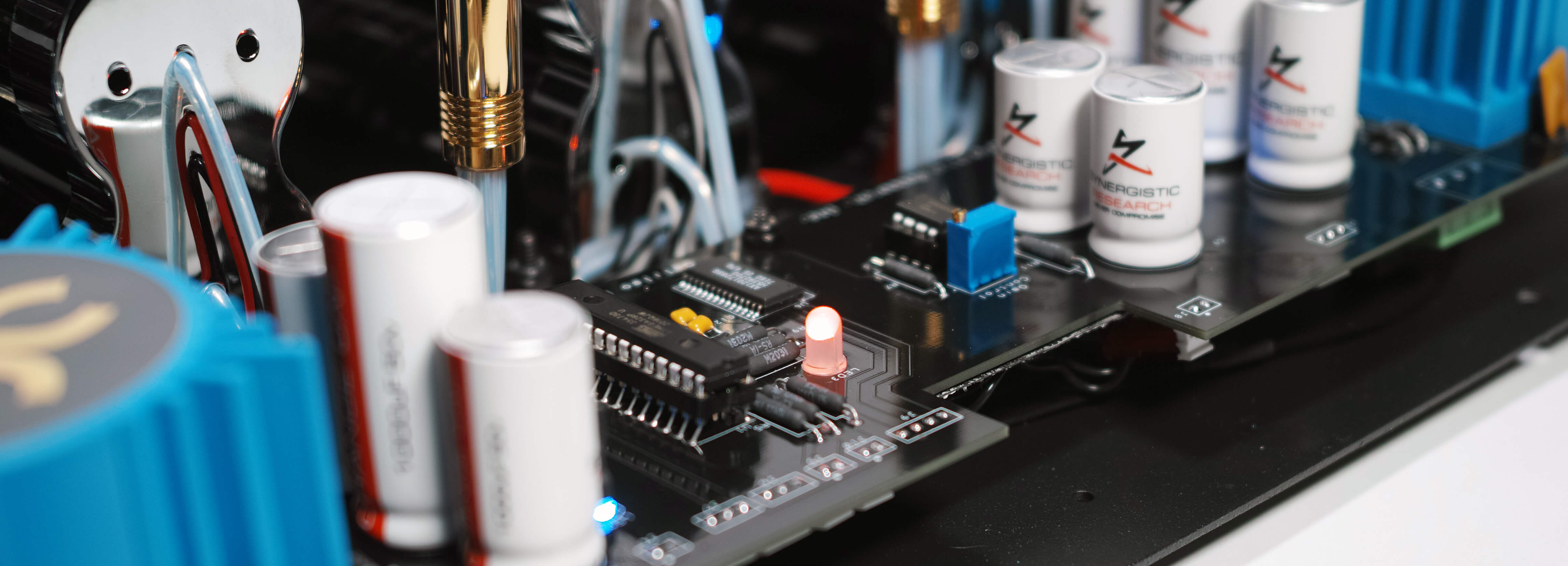
NEW 2021 Galileo SX with Galileo SX Dual ULF Generator.
Dual 2 setting ULF Generator.
Galileo PowerCell SX is the first PowerCell to utilize a multi-frequency ULF Shuman Frequency Generator to complement both large and smaller-scale performances. To make accurate small and large scale soundstaging reality, we use technology first developed for our Atmosphere Acoustic Field Generators. Ultimately we perfected two new frequency combinations to perfectly complement large and small scale acoustic enviroments after first createing multiple combinations that proved unncecessary in the final stages of development. The mulit frequency bias of the intenal EM Cell is similar to what you hear when comparing our original FEQ field generator to an Atmosphere Acoustic Field Generator, which presents music on a grander scale with improved dynmaics and musicality. To optimize the Galileo PowerCell SX to your system and personal tastes, press a button to switch between Red and Purple settings selecting the option that makes music in your stereo when playing your favority recordings.
- Redesigned dual frequency PCB w/ new regulated power supply and built-in Active Tranquility Pod.
- New Dual ULF Antenna configuration
- New Gold UEF tuning bullets
- Purple Outlets
- New UEF application on EM Cells
- New long duration quantum tunnel procedures
Two frequency bias, one perfect sound.
Blue Frequency: voiced for acoustic instruments, vocals, and smaller-scale performances. Note: Units manufactured before 12-5-2022 had this setting as red
Red Frequency: convincingly portrays large-scale performances and electronic music. Note: Units manufactured before 12-5-2022 had this setting as purple
What’s inside?
The Galileo SX PowerCell starts with the same technology as our world-beating PowerCell 12 SE line conditioner and adds five additional folded Active Electromagnetic Cells for a total of eleven Active EM Cells to the PowerCell 12 SX’s six Active EM Cells. Furthermore, all eleven Active EM Cells are larger and more densely packed for four times the total surface area, and this translates into a dramatic increase in EM Cell efficiency with over twice the stored energy for a sound that is more dynamic with greater apparent dynamic range.
More
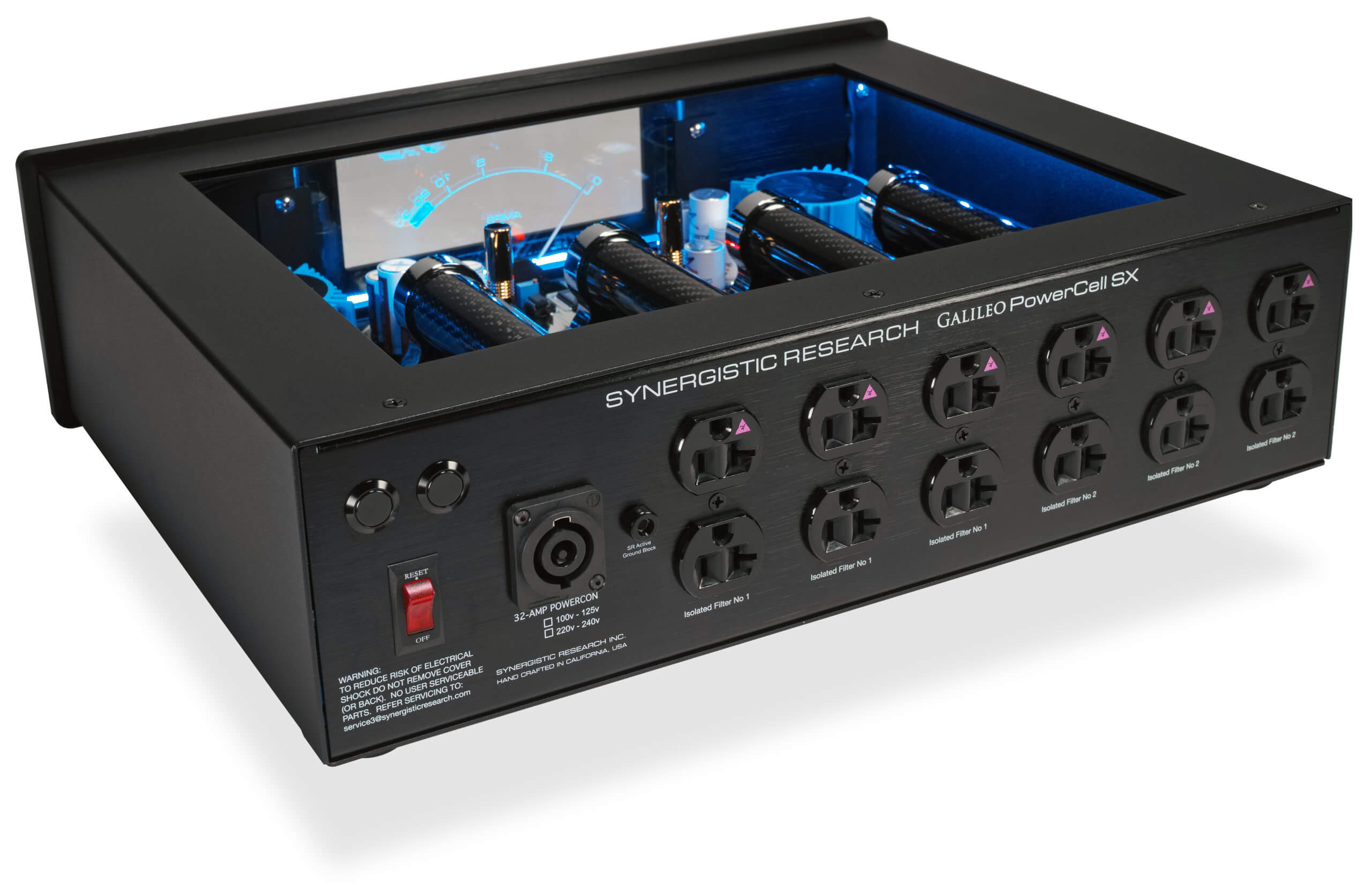
Eleven Active Electromagnetic Cells.
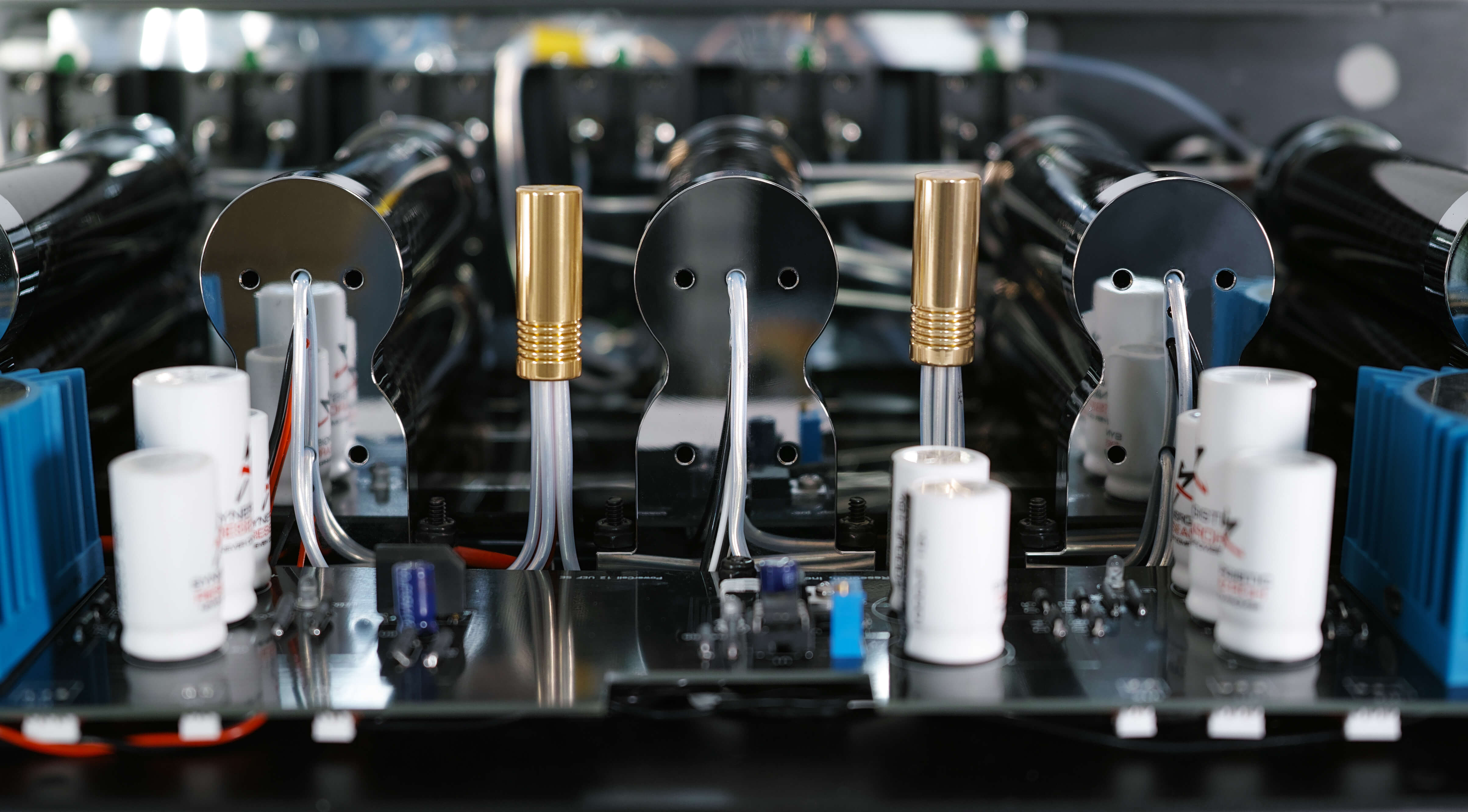
Solid silver 14awg wiring
Fifty-nine feet of 99.9999% silver.
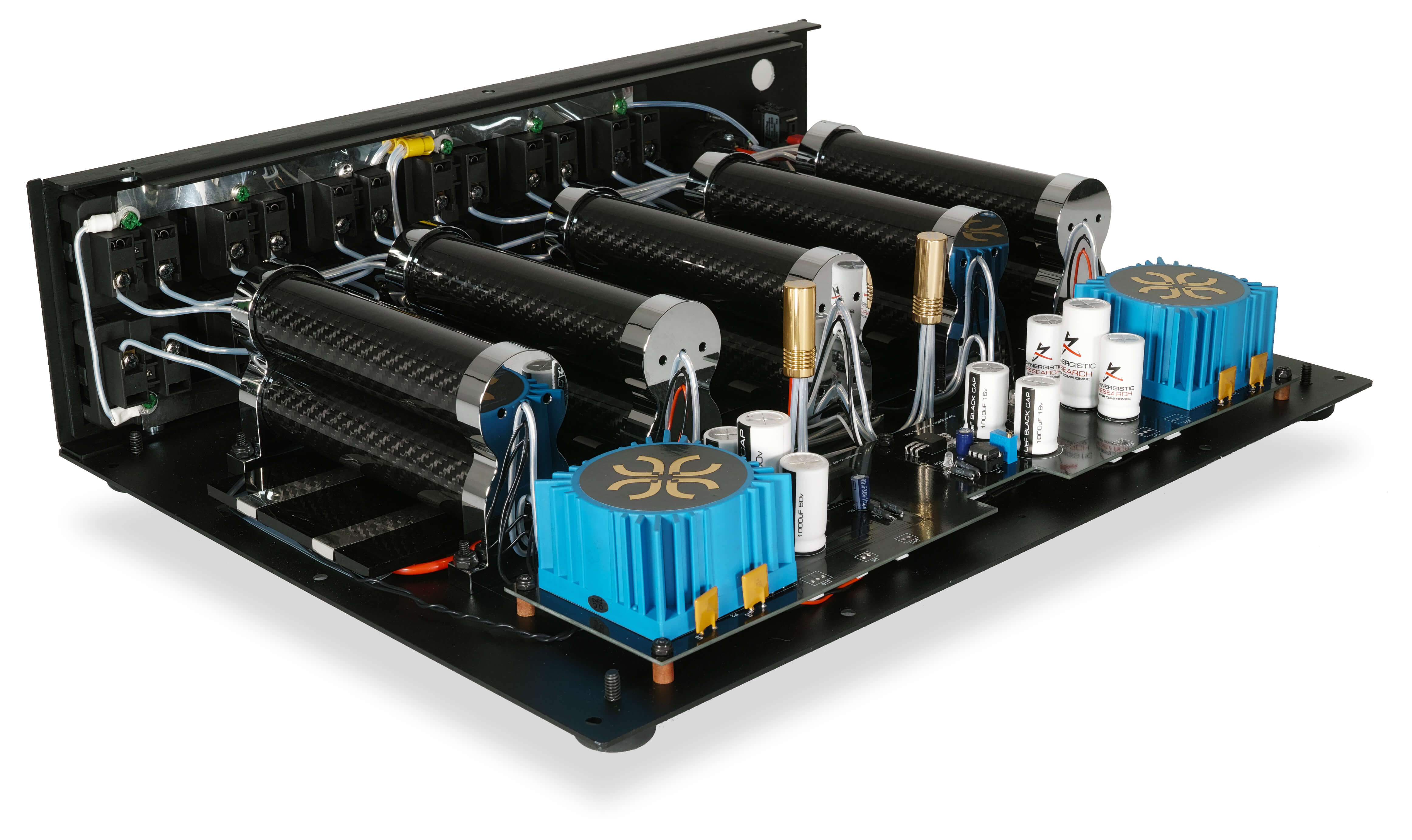
Ammeter
Galileo PowerCell SX specifications:
MSRP
$27,995 with 6ft. SRX power cable

Synergistic Research PowerCell SX
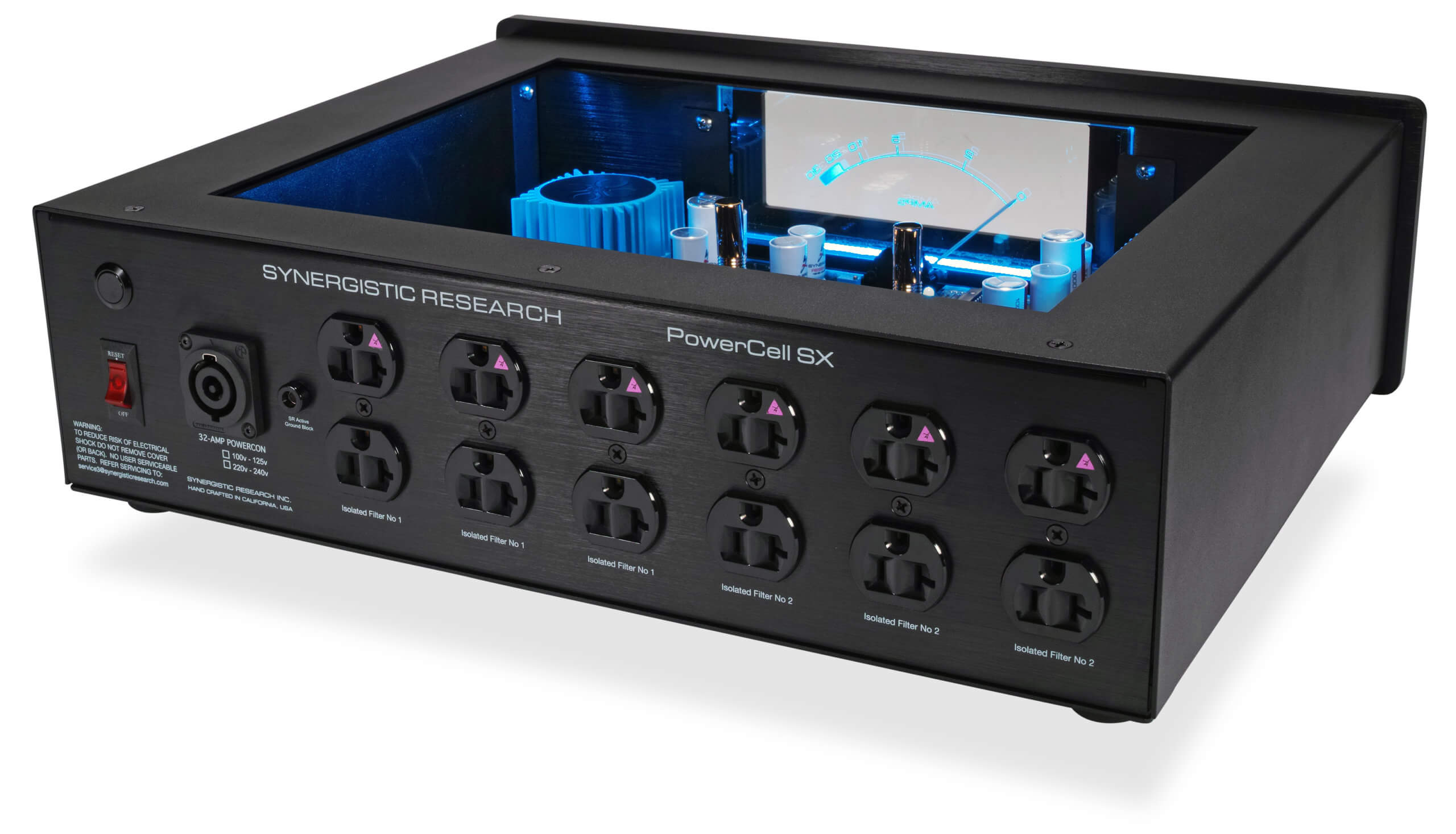
“An overview of Synergistic Research’s product line will find something from a continuum of ‘mild’ to ‘wild’. The divide is probably most noticeable between products in the signal chain – like the PowerCell SX tested here – and those outside (like the brand’s Acoustic Dots). In fact, if you dig a little deeper, they are all part of the same developmental Unified Energy Field concept, and those who ‘get’ Synergistic Research will just counter that some struggle to intuit the company’s whole systemic concept and just stay with the parts connected to the hardware. There are a lot of parallels between Synergistic Research and those making an ever-more intricate system approach to sound reproduction; it’s that Synergistic Research goes deeper down the rabbit hole than most.
The PowerCell SX power conditioner features conditioning and filtration technologies drawn down from the company’s no-longer-available flagship Galileo SX PowerCell. This means six active electromagnetic cells fed by the Galileo SX’s power supply. These cells are improved over previous editions (trickle-down from the Galileo SX once again) and are a good source of power filtration (almost four times beefier than its predecessor) and EMI/RFI suppression.
That’s not all If filtration, interference suppression and the consequent noise floor lowering were the only roles allocated to the PowerCell SX, it would still be relevant. But this is just the start. However, things get a little more ‘out there’ in Synergistic Research’s classic style after this. First, it uses the company’s Orange Capacitors and Purple Duplex power inlets. Then it adds field generators, bringing the PowerCell SX in line with the company’s other UEF-based line. However, 24k Gold UEF circuits are drawn from the Galileo SX this time. That brings a next-gen level of fine-tuning to the PowerCell SX.
From here, the PowerCell SX adds a Schumann Resonance Generator to power and bias its active EM cells. A who in the what now? Schumann Resonances are low-frequency electromagnetic waves, caused by lightning discharges creating resonance between the surface of the earth and the ionosphere. Estimates say there are about 2,000 thunderstorms on Earth at any moment, and the EM resonance they create makes a set of spectrum peaks at 7.83Hz, with harmonics up to 33.8Hz. This Schumann Resonance has been dubbed the Earth’s ‘heartbeat’, and the frequency is also generated in the PowerCell SX.
There is also provision to ground the PowerCell SX to a Synergistic Research Active Ground Block without using a power outlet. You also get a back-lit, semi-transparent power meter on the front panel. This is similar to the Ghost Meters used by Audio Research, but this one lacks the glowing tubes behind the glass. Still, it looks great!
Determining whether using the Schumann Resonance Generator and the like adds anything tangible beyond the PowerCell SX’s intrinsic performance as a good conditioner is a bit of a tough call. If you get what Synergistic Research does, these are core elements in building a superior-sounding system. You’ll know then, that the PowerCell SX and all its component parts result from extensive blind listening tests by Ted Denney and the Synergistic Research team. As a result, you’ll consider the PowerCell SX as a core part of a Synergistic Research approach to system optimisation. If not, you are still left with a good-sounding conditioner.
Foundation or not? I am using the PowerCell SX in either an entirely non-Synergistic Research treated system or at most one with the Foundation SX cables (tested in Issue 217) and the Black Box bass resonator (tested in Issue 214) in the system. As a result, I will separate the PowerCell SX from its additional field-effect claims, as much as possible. As they are intrinsic to the properties of the PowerCell SX, that’s a big ask, but at least I am trying not to place it in an entirely sympathetic system. Nor, for that matter, will I place it in an entirely unsympathetic system (such as mixing Synergistic and Shunyata, as they are like the Sharks and Jets of brands with ‘Research’ in the name, but with less dancing).
The PowerCell SX on its own does a lot for a system. Sure, it has the ‘none more black’ dark backgrounds and low noise presentation found in many good conditioners, and it leaves the sound in a good dynamic and rhythmic place, as befits some of the best in ‘best for conditioners and filters. The ‘first, do no harm’ maxim is honoured surprisingly infrequently with power products, as many lean out the dynamic shading as they clean up power chow. The non-current-limiting PowerCell SX is one of the rare exceptions, and for that alone, it gets into the top tier and deserves high praise.
Where the PowerCell SX begins to step beyond ‘high praise’ is its ability to correctly deal with tonal densities of a note, the raw vibration that ensues, and to separate one from another. This gives the music a sense of harmonic and timbral structure that is often robbed by the juice and not fixed in many conditioners.
I made a rookie error here; I mistakenly thought the PowerCell SX was boosting the size and depth of the soundstage. However, on closer listening, it was more than a combination of better silences between the notes and the PowerCell SX’s ability to tease out the structure of the music gave the impression of greater soundstage depth and width. That said, there was a feeling that music was unleashed from the cabinets more when the system was harnessed to the PowerCell SX.
Joie de vivre Most of all, however, the PowerCell SX simply brings out the joie de vivre in a recording. In making the track more engaging, it makes it more impassioned… no matter the music.
Now, back to the Synergistic Research concept album. Not only does the PowerCell SX work in that context, I’d argue it should be the beachhead for the Synergistic invasion. It brings a sense of order to even the least chaotic power, and that makes it hard to put back in its box.”
Alan Sircom – Hifi+ – November 2023
Description
The 2021 Galileo PowerCell SX starts with a complete redesign of its PCB power supply and ULF Signal Generator while keeping all non-conflicting PCB advancements from last year’s model. The first step was to create a multi-frequency ULF generator that splits the balance between intimate, focused recordings and large-scale recordings for a perfect yin and yang of the two. The Red setting is voiced for smaller-scale performances and is especially suited to recordings of analog instruments. Setting Purple is voiced to portray large-scale recordings accurately. It is ideally suited to recordings with massive sound fields like Pink Floyd or any modern recording mastered to portray extreme stereo imaging. To make this possible, we borrowed technology from our Atmosphere Acoustic Field Generator that generates the Earth’s Shuman Resonance plus harmonics of the Earth’s Shuman Resonance simultaneously over two channels to model different acoustic environments. As a result, the Galileo PowerCell SX is the first PowerCell to utilize more than one ULF frequency when biasing its internal EM Cells. We then added technology from our Tranquility Pod to create a uniform EM field beneath the PCB and power supply for a lower noise floor with improved dynamics and soundstaging. We then improved fundamentals like 33% larger and more densely packed folded EM Cells for a significant increase in AC filtration that lowers a system’s perceived noise floor with improvements in dynamics. We then designed a new Purple Duplex with all Purple Fuse technologies for sonic improvements precisely like our state-of-the-art Purple Fuses. Finally, we revoiced the internal Gold UEF tuning circuits to tie the sum of all advances together with a focus on natural sound first, along with improvements in soundstaging. Together these changes result from innovation perfected through 100’s of hours of measurements and listening tests and is the single most significant leap in Galileo PowerCell performance since the introduction of the first 11 x EM Cell Galileo PowerCell of 2019.
Global MSRP $27,995 and is limited to 50 units world-wide
(with included 6ft SRX Power Cable , $10,000.00 value)
SRX AC Cable specifications:
MSRP
$10,000 / 6ft.
$1,000 per addl. foot
Construction:
- Each SRX AC Power Cable is made from 10 seperate power cables – 4 each High Current Pure Solid Silver Strings, 2 Pure Silver Air Strings, 2 each Pure Silver Air Ribbons, 1 each Pure Copper Mesh Ground Plane, 1 each Pure Copper Active Shield.
Dimensions:
- Standard 6 and 8 ft. lengths
4 each 14 awg. 99.9999% Pure Silver High Current:
- Dielectric: PTFE Air (Sealed)
- Shielding: Active Shielding Technology
- Geometry: 2 Channel
- Listened to determine signal direction before build
2 Each Silver Air String:
- Silver Air Strings: 99.9999% pure mono crystal silver conductor
- Dielectric: PTFE Air (sealed)
- Shielding: Active Shielding Technology
- Geometry: 2 Channel
- Listened to determine signal direction before build
2 each Pure Silver Air Ribbons :
- 99.9999% pure silver conductor
- Dielectric: PTFE Air (sealed)
- Shielding: Active Shielding Technology
- Geometry: 2 Channel
- Listened to determine signal direction before build
1 each Pure Copper Ground Mesh :
- UEF Ground Plane Technology
- 36 square inches per 6 ft. length
Shielding :
- UEF Active Shielding 3rd generation,
- UEF Active EM Cell
- Swiss Made Power Supply
- SR Quantum Capacitors
- Point to Point Wiring
- Silver Solder 4%
Quantum Tunneling:
- Custom
5 Day burn in :
- 3 Step process
Voltage and current rating :
- US: 20amp/125v
- International (EU/AU/UK): 16amp/250v
Shielding :
- UEF Active Shielding 3rd generation,
2 each SR 25 UEF Folded Electro-Magnetic Cells:
- Pure Copper Foils
- UEF: Graphene treated pcb
- Dielectric: PTFE
- Shielding: Active Shielding Technology
- Housing: Carbon Fiber Cylinder
1 each SR 25 Active Shielding UEF Cell:
-
- Modified Swiss-made DC bias Power Supply
- UEF: Graphene treated pcb
- SR Quantum Capacitors
- Dielectric: PTFE
- Shielding: Ground Plane Technology
- Housing: Carbon Fiber Cylinder
2 each SR 25 UEF Ground Plane:
-
- Pure Copper Foils
- UEF Graphene
- Dielectric: PTFE
- Conductive Carbon Fiber Ground Sleeve
1 each Black SR25 UEF Active Module:
- Completes Active bias circuit
1 each Gold SR25 UEF Tuning Passive Module:
- Optional voicing for increased warmth, liquidity
1 each Silver SR25 UEF Tuning Passive Module:
- Optional voicing for maximum information and refinement.
Connectors:
- Connector Input US: 1 each Synergistic Research G08 Pure Rhodium
- Connector Input Int’l: 1 each Synergistic Research G08 Pure Rhodium Schuko
- Connector Output US: Synergistic Research G08 Pure Rhodium IEC 15 amp and 20 amp connectors
- Connector Output Int’l: Synergistic Research G08 Pure Rhodium IEC 15 amp and 20 amp connectors
Build Notes:
-
- 36 point-to-point hand soldered connections
- Hand laminated layers of Silver Ribbon, PTFE Film and Copper mesh
- Folded Hot and Neutral Electro-Magnetic Cells added before Power Supply
- UEF Ground Plane Sleeve added to EM Cells
- Additional UEF Ground Plane added to power supply
- SR25 UEF Treatment: UEF with Graphene added to entire cable
- 1 Termination for SR25 Active Tuning Module (Black)
- 1 Termination for SR25 UEF Passive Tuning Modules (Gold and Silver)
- Silver Solder: 4%
- Quantum Tunneling: Before the Active power supply is incorporated all connections and cabling are treated with 1,000,000 volts of electricity at specific frequencies and pulse modulations, creating a canal in the conductor material and contact points at the molecular level that lets electrons to flow more freely. This also allows the “Active Shielding” to work more efficiently yielding the maximum amount of low level information through the conductors and provides for the highest amount of realism in your music
- 5 day Burn-in: 2 step process
- 100% Hand Crafted in our California factory






